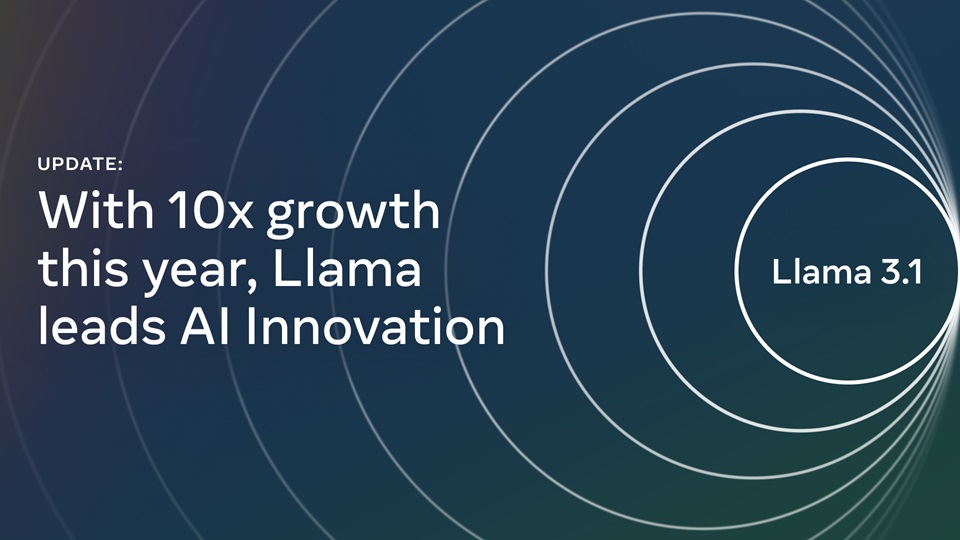Meta’s Llama series of AI models has rapidly emerged as the leading open-source family, amassing an impressive 350 million downloads globally on Hugging Face. Notably, 20 millions of these downloads occurred just last month, highlighting the model’s growing popularity.
According to a recent blog post by Meta, the usage of hosted Llama models, measured by token volume across major cloud service providers, more than doubled between May and July 2024, coinciding with the release of Llama 3.1. Furthermore, from January to July 2024, monthly token usage of Llama surged tenfold among some of the largest cloud platforms, reflecting its escalating adoption and impact in the AI landscape.
5 Reasons for Meta’s Llama LLM growth
- Performance improvements: The latest Llama 3.1 model has significantly closed the gap in quality compared to top proprietary models like GPT and Claude. This makes Llama a compelling open-source alternative for building high-quality AI applications.
- Vibrant open-source ecosystem: There are already over 60,000 derivative models of Llama on Hugging Face, showing a thriving community of developers fine-tuning it for various use cases. This open ecosystem is a key advantage.
- Rapid growth in usage: Llama downloads have surged to 350 million globally, with 20 million in the last month alone. Usage on major cloud platforms like AWS, Azure, Google Cloud etc. more than doubled from May to July 2024 and grew 10x from January to July for some providers.
- Partnerships and integrations: Llama is being accessed through Meta’s cloud partners like AWS, Azure, Google Cloud etc. and the company says many more want to partner, including Wipro, Cerebras and Lambda. This expanding partner ecosystem is driving adoption.
- Adoption by large enterprises: Major companies like AT&T, DoorDash, Goldman Sachs, Shopify and Zoom are already using Llama, further validating its capabilities.
7 Key features of Llama that attract developers
- Open-Source Accessibility: Llama models are open-source, allowing developers to access, modify, and integrate the models into their own applications without the restrictions often associated with proprietary models. This fosters innovation and collaboration within the developer community.
- High Performance: The latest version, Llama 3.1, has demonstrated significant improvements in performance, closing the gap with leading proprietary models like OpenAI’s GPT and Anthropic’s Claude. This makes it a competitive choice for developers looking for quality in their AI applications.
- Customizability: Developers have the flexibility to fine-tune Llama models for specific use cases, enabling them to create tailored AI solutions that meet their unique requirements. This level of customization is particularly appealing for businesses with specialized needs.
- Rapid Adoption and Community Support: The Llama models have seen rapid adoption, with millions of downloads and a vibrant community on platforms like Hugging Face. This community support provides developers with resources, shared experiences, and collaboration opportunities.
- Integration with Major Cloud Providers: Llama is accessible through various cloud platforms, including AWS, Azure, and Google Cloud, which facilitates easy deployment and scalability. This integration allows developers to leverage existing cloud infrastructure for their applications.
- Wide Range of Applications: Llama’s versatility enables its use across various industries and applications, from natural language processing to data analysis, making it an attractive option for developers in different sectors.
- Strong Ecosystem of Derivative Models: With over 60,000 derivative models available, developers can build upon existing work, accelerating the development process and fostering innovation in the AI space.
Llama’s unique architecture
Llama’s modular design, efficient tokenization, scalable training, lightweight deployment, and open-source availability make it an attractive choice for developers looking to build high-performance, customizable language AI applications. These architectural choices have likely contributed significantly to Llama’s rapid growth in adoption. The Llama series of large language models from Meta has several architectural features that contribute to its strong performance and rapid adoption:
- Modular Design: Llama employs a modular architecture that allows for easy customization and fine-tuning. This modular approach makes it simpler for developers to adapt the model to their specific use cases without having to retrain the entire model from scratch.
- Efficient Tokenization: Llama uses an efficient tokenization scheme that enables it to process text more quickly and with less memory usage compared to some other LLMs. This allows for faster inference speeds and the ability to handle longer input sequences.
- Scalable Training: The training process for Llama is designed to be highly scalable, allowing Meta to efficiently train larger and more capable versions of the model as more compute power becomes available. This scalability is a key factor in the rapid performance improvements seen in recent Llama releases.
- Lightweight Deployment: Llama models are relatively lightweight compared to some other large language models, making them easier to deploy in production environments. The smaller model size translates to faster inference times and lower hosting costs for organizations deploying Llama-based applications.
- Open-Source Availability: Perhaps most importantly, Llama is available as open-source software, allowing developers to access and modify the model’s architecture and code. This open approach fosters a vibrant ecosystem of derivative models and applications built on top of Llama.
According to a survey from Artificial Analysis, an independent site for AI benchmarking, Llama was the number two most considered model and the industry leader in open source. “Open-source wins. Meta is building the foundation of an open ecosystem that rivals the top closed models and at Groq we put them directly into the hands of the developers….We can’t add capacity fast enough for Llama. If we 10x’d the deployed capacity it would be consumed in under 36 hours,” said Jonathan Ross, Founder & CEO, Elon Musk’s AI project Groq.


